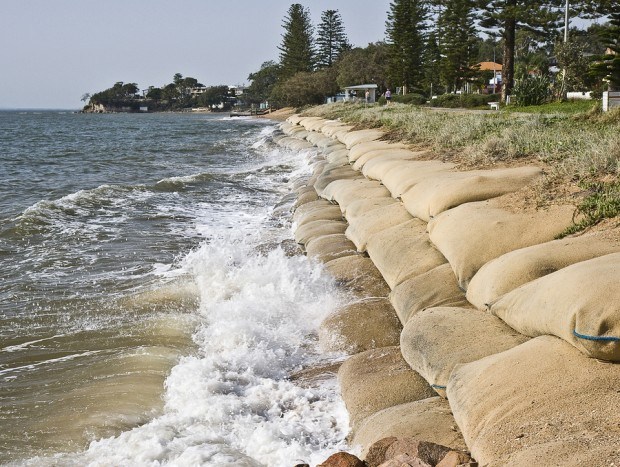A bulletin from Lloyd’s of London warns that, “as sea levels rise, ground levels in coastal megacities are also falling – with potentially disastrous implications for insurers. Insurers of large property portfolios in the world’s great coastal cities will have factored the effects of climate change into their catastrophe models – including rising sea levels and more frequent storm surges. But what’s often missed is that many of these cities are sinking faster than the water is rising. In some, subsidence outstrips sea level rise by a factor of ten to one.”
The subsidence heightens the potential losses from rising sea levels. Combined with “sea water inundation and flood damage, this can have disastrous consequences for the built environment – and property and business interruption insurers.” Gilles Erkens, of the Deltares Research Institute in Utrecht said: “We’re going down and the sea is coming up. Potential losses could run into hundreds of millions of dollars every year.”
As an example Lloyd’s singled out the “surge that overwhelmed New Orleans following Hurricane Katrina, and the subsequent cascading collapse of critical infrastructure,” which it said “offered a glimpse of the sort of scenario underwriters fear.”
There are a number of causes contributing to subsidence conditions. “Foremost is large-scale groundwater extraction for drinking water and industrial processes,” said the report. “Although elsewhere, like Los Angeles, it is oil and gas extraction that is to blame. Some urban areas are also constructed on multiple layers of soft soil, which compacts when built on – one of the problems facing New Orleans, for instance, and a feature of megacities that spring up on river deltas, such as Guangzhou in south west China.”
A major city like Tokyo evinces the conditions. Lloyd’s explained that the city “grew rapidly in the middle of the last century and sunk over four meters [13+ feet] as a result – until drastic remedial measures were put in place in the 1970s to restrict the extraction of groundwater. Since then the subsidence has stabilized. But from Jakarta and Dhaka to Venice, the risks are still all too real.
“Jakarta is subsiding faster than any other megacity. The northern part has sunk by nearly four meters in the last 35 years, mainly due to groundwater extraction as the population has mushroomed and former agricultural land has been taken over by massive residential and industrial developments.”
The city is “sinking five to ten centimeters [1.27 to 2.54 inches] a year, and this has already “severely damaged buildings and infrastructure,” as “increased flooding in densely populated areas, destroyed local groundwater systems and increased seawater intrusion. This has started to threaten key commercial districts of the city, where many major Asian, American and European companies are based. It is here that the largest insurance exposures will be concentrated, and one of the reasons the authorities are now taking action.
To help cope with the threat, the Dutch Government is giving $4 million for a feasibility study to build a dyke (levee) around Jakarta Bay, drawing on its experience of protecting its own coastal cities, such as Rotterdam.
“In January this year, the Indonesian Government also agreed to build two new dams and a 1.2 km [3/4 of a mile] flood relief tunnel. Plus, there are plans to expand the reservoirs that serve the conurbation of 28 million people that surrounds Jakarta, so that new restrictions can be imposed on the extraction of groundwater for both domestic and industrial use.”
The situation is also severe in Venice, which has sunk “about 120mm [4 ¾ inches] in the 20th century due to natural and human causes. In addition, the sea level rose about 110mm [41/3 inches]. A range of measures – such as restrictions on groundwater extraction – were introduced to stabilize the problem. But recent satellite mapping suggests these may not be enough, as the city is still subsiding by one to two millimeters a year.
Lloyd’s noted that the causes are two-fold: “First, the Adriatic plate, on which Venice sits, is slowly sliding beneath the Apennine Mountains and causing the city and its environs to drop steadily. The area is also tilting by a millimeter or two eastward every year.
“The second cause is the restoration of its historic buildings.” Pietro Teatini, a researcher from the University of Padova, told the BBC: “When some people restore their buildings, they load them and they can go down significantly by up to five millimeters in a year.”
Lloyd’s warned that these conditions, “coupled with the threat of rising sea levels, estimated to be between three and ten millimeters a year,” causes a “persistent fall in ground level, which could “prove a perfect storm for insurers.
“And, unless there’s better co-operation between property owners, authorities and commercial interests, it will hit Venice in the next decade, says the University of Padova’s research team. Currently, a multi-billion dollar project to build new barriers that can be raised in the face of high tides is underway.”
Source: Lloyd’s of London
*This story previously ran in our sister publication Insurance Journal.





















 The Insurance Data Paradox: Structure Creates Flexibility
The Insurance Data Paradox: Structure Creates Flexibility  Travelers: Distracted Driving Incidents Continue to Rise
Travelers: Distracted Driving Incidents Continue to Rise  Time-Tested Loss Reserving Methods Challenged: AM Best
Time-Tested Loss Reserving Methods Challenged: AM Best  AM Best Downgrades State Farm General Ratings
AM Best Downgrades State Farm General Ratings 









